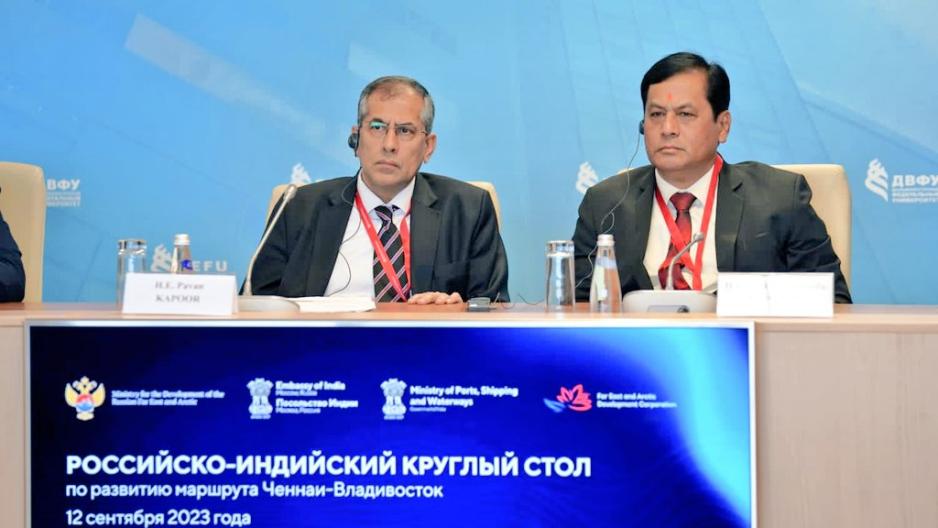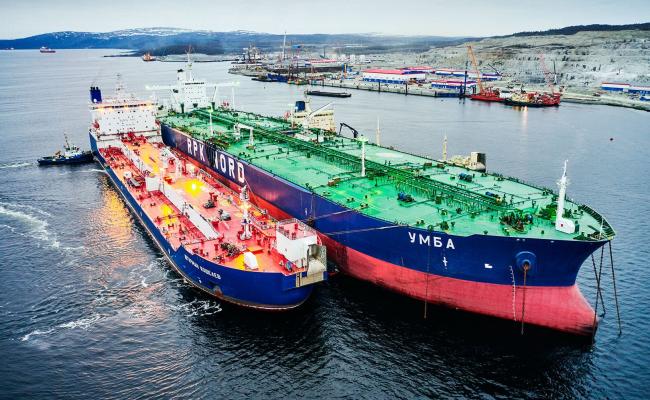India Looking To Cooperate With Russia on Development of Arctic Northern Sea Route

Russian-Indian maritime meeting in Vladivostok. (Source: Indian Ministry of Ports, Shipping and Waterways)
Following an initial high-level meeting between Indian and Russian officials in India in March of this year, representatives from two countries now met in Vladivostok to further discuss a deepening of cooperation in Arctic shipping and related economic activity.
Indian and Russian officials discussed a wide-ranging cooperation in Arctic shipping between the two countries. India’s Minister of Ports, Shipping, and Waterways, Mr. Sonowal, met with Russia’s Minister for the Development of the Far East and the Arctic, Mr. Chekunkov, in Vladivostok last month.
A primary item of discussion was the development and usage of Russia’s Northern Sea Route and the proposed adjacent Eastern Maritime Corridor (EMC), which connects Far Eastern Russia to India’s port city of Chennai.
"[We discussed] the operationalisation of the EMC, and we envision pertinent stakeholders involved in the trading and transportation of potential commodities such as coking coal, oil, and liquefied natural gas along this corridor,” explained Mr. Sonowal.
His Russian counterpart, Mr. Chekunkov stated:
“We discussed the development of maritime communications between our countries, as well as the prospects for using the Northern Sea Route.”

Map showing the Northern Sea Route and Eastern Maritime Corridor in relation to India. (Source: Author’s own work)
India already buying coal and oil
Thus far India’s engagement on the route and the receipt of goods shipped via the NSR has been more limited. In contrast, its neighbor China is receiving increasing amounts of hydrocarbon resources via the route and a Chinese shipping company has established regular container ship service between the two countries.
But India already plays a significant role in cargo traffic coming out of Russia’s Arctic port of Murmansk in a westward direction, via traditional shipping routes. Out of 8m tons of cargo during the first seven months of 2023, India accounted for 35 percent, primarily in the form of coal and some crude oil.
The NSR, however, does represent significant potential for the country, Mr. Sonowal confirmed.
“India is keen to collaborate [on] a partnership regarding the development of the Northern Sea Route, recognising the potential it holds for enhanced connectivity and trade.”
Russia also highlighted that India stands to gain from economic activity related to Arctic shipping, such as shipbuilding.
An opportunity to increase sales of shipbuilding products
“The NSR is a global transport project. Its development can provide economic benefits to both Russia and non-regional states. For India, this is an opportunity to increase sales of shipbuilding products and gain income from participation in the general logistics business in northern latitudes,” concluded Mr. Chekunkov.
Officials also emphasized that the Arctic corridor will be key from an economic and geopolitical perspective for India, which is intent on diversifying its supply chains and developing alternative transport corridors.
The cooperation agreement extends to training of Indian seafarers with planned courses for navigation in polar and Arctic waters at the Russian Maritime Training Institute in Vladivostok.
Climate change affecting trade routes
For India the distance savings the NSR provides would be less significant than for China. Nonetheless, the route could represent a valid transport corridor for India, especially for the receipt of Russian oil and LNG resources.
Following Western sanctions on Russian oil, India has already emerged as the marginal buyer of the country’s crude, with large volumes now flowing from the Baltic and Black Sea to India.
Additionally, Arctic shipping routes represent an alternative corridor during times when traditional routes, such as the Suez Canal or Panama Canal experience slow-downs or closures.
Climate change, which has resulted in the melting of Arctic sea ice and the seasonal opening of the NSR, has at the same time negatively affected the Panama Canal. Global warming and an ongoing drought due to changing weather patterns have affected the water levels in Gatun Lake, part of the canal route.
The lake’s waters are used to fill and drain the massive canal locks. Low water levels have resulted in restrictions in the number of daily vessel passages, leading to weeks-long maritime traffic jams on both sides of the canal.



